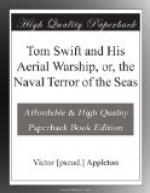At the stern of the big bag was the motor-room, where gas was generated to fill the balloon compartments when necessary, where the gasoline and electrical apparatus were installed, and where the real motive power of the craft was located. Here, also, was carried the large quantity of gasoline and oil needed for a long voyage. The Mars could carry sufficient fuel to last for over a week, provided no accidents occurred.
There was also an arrangement in the motor compartment, so that the ship could be steered and operated from there. This was in case the forward pilot-house should be shot away by an enemy. And, also, in the motor compartment were the sleeping quarters for the crew.
All three suspended cabins were connected by a long covered runway, so that one could pass from the pilot-house to the motor-room and back again through the amidship cabin.
At the extreme end of the big bag were the various rudders and planes, designed to keep the craft on a level keel, automatically, and to enable it to make headway against a strong wind. The motive power consisted of three double-bladed wooden propellers, which could be operated together or independently. A powerful gasoline engine was the chief motive power, though there was an auxiliary storage battery, which would operate an electrical motor and send the ship along for more than twenty-four hours in case of accident to the gasoline engine.
There were many other pieces of apparatus aboard, some not completely installed, the uses of which I shall mention from time to time, as the story progresses. The gas-generating machine was of importance, for there would be a leakage and shrinking of the vapor from the big bag, and some means must be provided for replenishing it.
“You don’t seem to have forgotten anything, Tom,” said Ned admiringly, as they soared upward.
“We can tell better after we’ve flown about a bit,” observed the young inventor, with a smile. “I expect we shall have to make quite a number of changes.”
“Are you going far?” asked Mr. Damon.
“Why, you’re not frightened, are you?” inquired Tom. “You have been up in airships with me before.”
“Oh, no, I’m not frightened!” exclaimed the odd man. “Bless my suspenders, no! But I promised my wife I’d be back this evening, and . . . "
“We’ll sail over toward Waterford,” broke in Tom, “and I’ll drop you down in your front yard.”
“No, don’t do that! Don’t! I beg of you!” cried Mr. Damon. “You see—er—Tom, my wife doesn’t like me to make these trips. Of course, I understand there is no danger, and I like them. But it’s just as well not to make her worry-you understand!”
“Oh, all right,” replied Tom, with a laugh. “Well, we’re not going far on this trip. What I want to do, most of all, is to test the guns, and see if the recoil check will work as well when we are aloft as it did down on the ground. You know a balloon isn’t a very stable base for a gun, even one of light caliber.”




